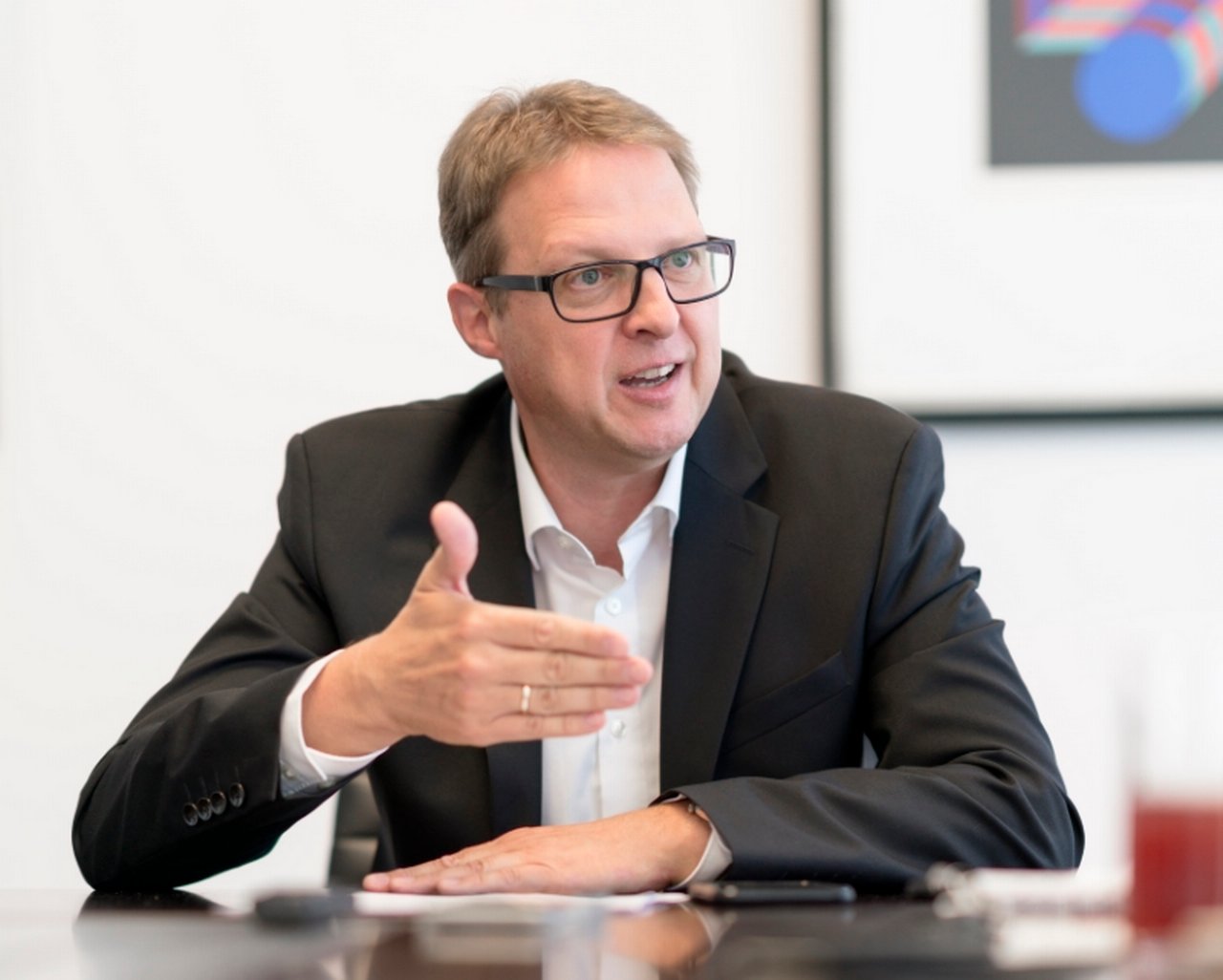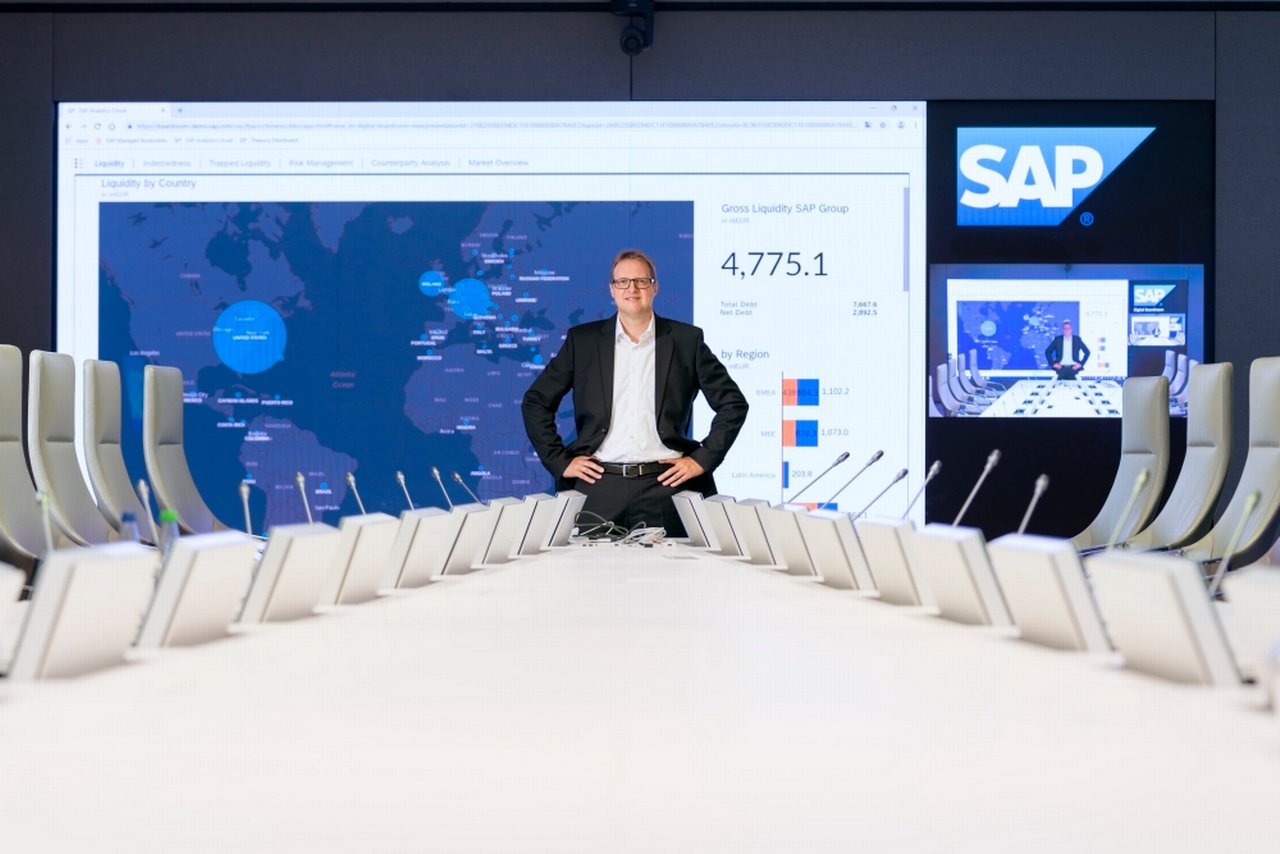September 2019
Business software provider SAP leads a consistent programme of innovation, the latest being its digital boardroom. Head of Global Treasury Steffen Diel demonstrates why leaving one’s comfort zone and being permanently curious can work miracles
Shortly before the reunification of Germany in 1989, one young Deutsche Bank vocational trainee at the Mannheim office found himself in East Germany when Berlin-based Deutsche Kreditbank sold the corporate and private banking deposit-taking business to Germany’s largest bank as part of the currency union.
“It was an exciting time and an absolute highlight of my training,” says Steffen Diel, now Head of Global Treasury at enterprise application software provider SAP. “Our counters were open for 10 hours a day and there was a constant flow of people wanting to invest their money in savings plans and other products,” he recalls. This was the first time savers had encountered a Western bank and it was a round-the-clock operation to collect the East German marks and write the savings plans.
In the H1 2019 issue of flow, we talked to Stefan Gruber about the investor relations element of SAP, who provided the background to how SAP was founded and its growth trajectory.1 This second part of the story goes into the engine room – or digital boardroom – with Diel, sharing the corporate treasury perspective and revealing how SAP quite literally “drinks its own champagne” (as the company puts it) when designing winning treasury solutions.
In the beginning
Diel had always been interested in banking and asset management. “Where you can invest, and how you manage yield and risk, was, at an early age, one of my passions,” he reflects. And it was for this reason he selected Deutsche Bank in Mannheim “to lay a solid foundation” for his future career.
By 1996, Diel knew that his heart really lay in being part of the corporate treasury function rather than a banking career, so he took the plunge and moved to KUKA, the robotics producer, where he stayed for eight years. “I was working directly with the CFO and it was a great experience starting the treasury function from the beginning where you could design it properly and build connections to accounting and to the planning team.” As it happened, they implemented SAP as their enterprise resource planning (ERP) scheme at the time, with treasury being the very first module.
“Sometimes people ask me if 20 years or so in treasury is boring, and I always say the same thing – it is not, because treasury isn’t just treasury, it provides answers to accounting, tax, planning and investor relations questions every day, so I am always using the business administration I covered in my studies, and I can apply it on a very wide basis.” Diel believes it is this breadth of application that explains why people stay in treasury for a long time.
"A global presence of banks was a clear criterion when we decided on our core bank group"
Digesting growth
Nobody, says Diel, should notch up years with an organisation without checking their learning curve. And doing that can sometimes mean that it is time to move on. In 2006, he joined SAP as Head of Treasury Finance. He was responsible for group liquidity planning, financial risk management, subsidiary financing and the corporate finance remit such as external funding (e.g. mergers and acquisitions finance). Leading a team of four people, he joined just at the time when SAP was looking to the debt capital markets to fund its next phase of growth through acquisition. Up until then, he explains, “SAP never had any financial debt, not a single euro”.
First on the list was Business Objects, which SAP bought for €4.2bn, announcing its inclusion into the company on 22 January 2008. This marked a growing trend of consolidation in the business software industry – Oracle had acquired Hyperion in 2007 and IBM took over Cognos in 2008. A string of other acquisitions followed, including cloud-based business commerce company Ariba (US$4.3bn, May 2012) and expenses toolkit Concur (US$8.3bn, September 2018). “To take the mergers and acquisitions (M&A) path, we had to develop certain capabilities and expertise from scratch, constantly improving our effectiveness and transforming the financing structure,” reflects Diel. Up until that point, the treasury function was almost entirely focused in Germany, but as the company grew and developed into a global organisation regional treasury teams were set up. “Now we have a team of nine people from all around the world, from São Paulo to Shanghai and Beijing,” comments Diel.
SAP regularly publishes its Days Sales Outstanding and cash conversion ratio, which are, says Diel, “the most important metrics”. Inventory management isn’t really an issue, but overdue receivables involve senior management and SAP has customer councils that are focused on reducing these.

Capital Structure
"Treasury isn’t just treasury, it provides answers to accounting, tax, planning and investor relations questions every day"
When he arrived at SAP, one of Diel’s initial tasks was to write a white paper on capital structure. An updated extract of this was published by TMI in 2013.1 A proper understanding of a company’s capital structure is an important part of the treasurer’s curriculum, he says, because of “recurring strategic funding discussions with senior management”; and the increased importance of intangible businesses (knowledge-based industries) in the global economy during the past two decades compared with the role of traditional, tangible business models.
For a software company such as SAP in a constantly changing technology market environment it is important, says Diel, “to have the ability to seize opportunities as they arise”. This might be M&A opportunities, but also organic growth investment. “To ensure permanent access to debt financing it is important to have a strong credit rating,” Diel declares. “Since 2010 we have invested more than US$40bn in acquisitions [see Figure 1]. And while SAP is a very dynamic and growth-operating business, it has a somewhat conservative financial profile – which is what appeals to both debt and equity investors. The combination plays out very well.”
Figure 1: Selection of SAP acquisitions since 2012
- Nov 2018 - Contextor SAS. Robotic process automation technology and strategic for SAP S/4HANANov 2018 Qualtrics. Technology platform for experience data management, with 9,000 enterprises on the platform. US$8bn
- Jan 2018 - Recast.AI. Conversational artificial intelligence technology
- Sep 2017 - Gigya. Customer identity and access management
- Dec 2016 - Abakus. Cloud-based cross-channel marketing measurement solution
- Sep 2016 - Hipmunk. Travel search technology (to align with Concur)
- Sep 2016 - Altiscale. Big data-as-a-service solution
- Sep 2016 - Plat.One. Internet of Things platform
- Jun 2016 - Fedem. Engineering analysis and modelling software
- Feb 2016 - Roambi. Mobile-centric analytics and data visualisation solution
- Oct 2015 - Multiposting. French software-as-a-service recruiting software
- Sep 2014 - Concur. Cloud-based expense management and solutions. US$8.3bn
- Mar 2014 - Fieldglass. Contingent labour procurement and workforce management solution
- Jan 2013 - Ticket-Web. Online ticketing solutions for sports and entertainment venues
- May 2012 - Ariba. Cloud-based commerce network and spend management solution. US4.3bn
The full list since 2010 can be viewed at https://bit.ly/2Kvbvg4, sap.com
Rating preparations
SAP embarked upon its rating journey in 2014. “We started in the first quarter to prepare the process working with Moody’s and Standard & Poor’s,” recalls Diel. “By the summer we were all set with a single A rating on the horizon. But just a couple of weeks before the ratings committees met to finally decide on the rating, SAP made one of its biggest acquisitions ever [Concur], making our discussions with the ratings agencies void again.”
This is, apparently, a day in the life of treasury, and Diel was pleased that even with the additional debt volume of €7bn, the single A rating was preserved. Track record is imperative to ratings agencies, and SAP’s history of repaying debt quickly when it did not have a rating, combined with its very high cash flow, helped build the trust.

Diel at the head of SAP's digital boardroom
Inside the digital boardroom
“Competitive advantage cannot be understood by looking at a firm as a whole. It stems from the many discrete activities a firm performs in designing, producing, marketing, delivering and supporting its product,” declared the esteemed Harvard Business School Professor Michael Porter.3 Porter went on to classify the value chain into “primary activities” and “secondary/support activities”. Firm infrastructure, including finance, is in the “support” category, but actually holds the whole enterprise together. What SAP has done is develop a means by which organisations can bring both activities together into one dashboard.
At the heart of all this is the ERP system. The architecture has changed over the years – client/server having made way for cloud – but the principle has not. By positioning itself as the ‘must-have’ business application and analytics software, with a consistent innovation programme, the company has not only become the leading global business software provider in the world, but accepts the responsibility this brings when its tools are inside a customer’s enterprise. “We must help leaders in all sectors find the proper balance between human judgement and machine speed”, noted CEO Bill McDermott in the 2018 annual report to investors.4
Corporate treasury is a vital component of the support activities and Diel noted there was a huge opportunity to build proper functionality with instant reporting as part of the overall offering, although of course the ERP architecture does not prevent third-party providers connecting through an interface.
Diel and his treasury team became the perfect pilot customers. “We see in the treasury community what requirements treasurers have,” he explains. The flagship offering is SAP Treasury and Risk Management, which integrates with cloud-based SAP S/4HANA, the ERP for large enterprises that superseded the SAP R/3 (there is also an SME version). “Its development was heavily driven by my team,” says Diel. Gone are the days of endless customisations that got in the way of developing robust reporting solutions. Now, treasurers can set up dashboard solutions in the SAP Analytics Cloud designed especially for corporate treasury customers.5 This is, in turn, integrated into the overall digital boardroom that has feeds from the ERP, customer relationship management and human resources systems to provide, as the website puts it, “one source of truth across all business areas”.6 Without the need to connect to third-party technology via application programming interfaces (Diel is justifiably proud of the one-stop-shop approach), the dashboard provides a real-time view of major treasury risk and finance key performance indicators such as:
- Liquidity and investments;
- Financial risk;
- Indebtedness; and
- Trapped cash.
It also features market overview and scenario modelling tools. “We are working on a cash flow planning tool which is based on the enterprise’s profit and loss and the value driver tree, so you can get the benefit of multi-year planning,” says Diel.
77%
Using fictitious data, he demonstrates how the balance sheet exposures of all SAP subsidiaries around the world can be seen at the touch of a button. “Then you have a report where you can see the accumulated euro exposure of a certain legal entity… and as we drive via thresholds we see exactly which legal entities exceed the threshold,” he adds. When asked for a sample scenario, Diel explains: “If you are a treasurer and have the euro exposure of South Korea, for example, you don’t know what is behind the exposure. It could be a receivable against the US dollar. Or it might be a receivable against the Japanese yen. With this balance sheet exposure application you can drill down to the very last posting and see what drives the exposure.”
This is why, he says, SAP needs banks with a strong regional footprint. The company can’t be in all the countries that use its products. “A global presence of banks was a clear criterion when we decided on our core bank group,” he explains.
“We have had a very strong relationship with Deutsche Bank for a number of years,” Diel adds. “The bank has supported and driven most of our M&A finance transactions, but also in cash management, guarantee business as well as FX and interest rate management. We work closely together. And that obviously presents a broad and intense collaboration platform.”

Tomorrow’s treasury
SAP has never stood still, and the acquisition and product development history demonstrates how it builds out from the existing architecture that supports the overall vision of being an organisation’s blood supply network. When asked how he sees the next five years of driving the organisation’s treasury management – and helping develop the treasury portfolio – Diel says: “We should take the benefit of the SAP application environment like we did with the digital boardroom and dashboard, but also work on other use cases for new technologies.”
Right now the team is working on a fraud prevention project via a distributed ledger solution and an ‘intelligent’ (automated) hedging solution.
Our visit to the vast Walldorf headquarters near Mannheim brought back memories of another visit two decades earlier to the US Microsoft ‘campus’ in Redmond, Washington, where everyone seemed very at home in their work environment. Creativity and trying new things are also embedded in this company’s culture, along with its passion for continuous learning – and its people. Data scientists and technology experts need to be in an environment they can feel comfortable in – and the same applies to the finance team, which has designated roles such as stewards, business partners and transformation agents.
Diel is justifiably proud of SAP’s approach to diversity, which goes beyond well-written CSR reporting. As Executive Sponsor for SAP’s diversity and inclusion implementation for the board area, he reinforces the message that differently abled people (rather than ‘disabled’) bring unique innovation dimensions just as powerfully as cross-generational inclusion taps into different experience sets.7 Diel says this responsibility brings him “a lot of joy”.
“Above all, be curious,” he concludes. “And leave your comfort zone.” It’s clear that Deutsche Bank’s loss of a talented graduate trainee in 1996 has been SAP’s gain, and Diel is a key artery within the beating heart of what makes SAP such a special kind of enterprise.
The Deutsche Bank view
Working with SAP as both a client and a strategic partner enables Deutsche Bank to constantly challenge our business model and learn from one of the largest vendors in the enterprise software industry, particularly regarding the importance of treasury workflow integration. In an ever-evolving industry, we are proactively shaping the treasury of tomorrow, rather than being solely bound by the anticipated requirements of the market
Ole Matthiessen
Global Head of Cash Management
Deutsche Bank
The Deutsche Bank flow team talked to Group Treasurer Steffen Diel at the SAP Walldorf headquarters on 28 June 2019
Sources
1 See Investor Harmony at db.com/flow
2 See https://bit.ly/2MEL1vu at treasury-management.com
3 See https://bit.ly/2yR0dO5 at mbaknol.com
4 See https://bit.ly/2OZjgNc at sap.com
5 See Diel’s 12-minute video, ‘Interactive and Real-Time: SAP Treasury Dashboard’ at https://bit.ly/2vaU6lL, at youtube.com (April 2019)
6 See https://bit.ly/33cRXWt at sap.com
7 See https://bit.ly/3r0a50O at sap.com
Go to Corporate Bank EXPLORE MORE
Find out more about products and services
Go to Corporate Bank Go to Corporate BankStay up-to-date with
Sign-up flow newsbites
Choose your preferred banking topics and we will send you updated emails based on your selection
Sign-up Sign-upSubscribe Subscribe to our magazine
flow magazine is published annually and can be read online and delivered to your door in print
You might be interested in
CASH MANAGEMENT, TECHNOLOGY
Adding speed to treasury digitisation Adding speed to treasury digitisation
A global pandemic and fast-changing regulation are factors accelerating the digitalisation of treasury ecosystems across Asia, as a recent webinar from The Economist Group and EuroFinance confirmed. flow ’s Graham Buck reports on the main discussion points
CASH MANAGEMENT {icon-book}
Currency Care Currency Care
Dan Barnes explains how targeted use of derivatives can create more efficient hedging for FX risk, and provide treasurers with an alternative to incurring overnight deposit charges
CASH MANAGEMENT
more Covid-19's assault on cash
The journey towards tomorrow’s cashless society has gathered momentum and urgency as a result of the Covid-19 pandemic, reports flow’s Graham Buck



